“The Urban Poor and Vulnerable Are Hit Hardest by the Heat”: A Heat Equity Lens to Understand Community Perceptions of Climate Change, Urban Heat Islands, and Green Infrastructure
Abstract
:1. Introduction
- What are the community perceptions of and the connections between climate change, UHI, and GI? What type of public knowledge gap may exist about these connections?
- How do communities perceive urban heat equity and the practice of GI as a UHI mitigation strategy? What aspects of community perceptions should GI planners consider when developing strategies for UHI mitigation?
2. Background
3. Context, Methodology, and Data
3.1. Study Area and Context
3.2. Methodology and Data
3.2.1. Mapping of UHI, GI, and Disadvantaged Populations
3.2.2. Community Survey
3.2.3. Social Media Data Mining
4. Results
4.1. Mapping of UHI, GI, and Disadvantaged Populations
4.2. Community Survey Analysis
4.2.1. Overview
4.2.2. Community Perceptions and Sentiments Regarding UHI
4.2.3. Attribution of Heat to Climate Change and UHI
4.2.4. Perception of GI Presence
4.2.5. Attribution of GI to the Impact on UHI
4.2.6. Relationships between Respondent and Climate Change-UHI-GI Perceptions
4.3. X Data Analysis
4.3.1. Overview
4.3.2. Community Perception and Sentiment around Climate Changes, UHI, and GI
5. Discussion
5.1. Theme 1: Perceived Heat Inequity in Camden Triggers Negative Emotions
5.2. Theme 2: Public Knowledge Gap Exists Regarding Climate Change-UHI-GI Connections
5.3. Theme 3: Perceived Inequitable Distribution of GI May Negatively Impact UHI Mitigation Strategies
5.4. Theme 4: GI Planning and Implementation Should Be Used as UHI Mitigation Strategies with Caution
6. Concluding Remarks
Supplementary Materials
Author Contributions
Funding
Data Availability Statement
Acknowledgments
Conflicts of Interest
References
- Stone, B.; Vargo, J.; Habeeb, D. Managing climate change in cities: Will climate action plans work? Landsc. Urban Plan. 2012, 107, 263–271. [Google Scholar] [CrossRef]
- Heaviside, C.; Macintyre, H.; Vardoulakis, S. The urban heat island: Implications for health in a changing environment. Curr. Environ. Health Rep. 2017, 4, 296–305. [Google Scholar] [CrossRef]
- Rosenzweig, C.; Solecki, W.D.; Parshall, L.; Chopping, M.; Pope, G.; Goldberg, R. Characterizing the urban heat island in current and future climates in New Jersey. Glob. Environ. Change Part B Environ. Hazards 2005, 6, 51–62. [Google Scholar] [CrossRef]
- Keith, L.; Meerow, S. Planning for Urban Heat Resilience; American Planning Association: Chicago, IL, USA, 2022. [Google Scholar]
- Norton, B.; Coutts, A.; Livesley, S.; Harris, R.; Hunter, A.; Williams, N. Planning for cooler cities: A framework to prioritise green infrastructure to mitigate high temperatures in urban landscapes. Landsc. Urban Plan. 2015, 134, 127–138. [Google Scholar] [CrossRef]
- Yao, L.; Li, T.; Xu, M.; Xu, Y. How the landscape features of urban green space impact seasonal land surface temperatures at a city-block-scale: An urban heat island study in Beijing, China. Urban For. Urban Green. 2020, 52, 126704. [Google Scholar] [CrossRef]
- Kondo, K.; Mabon, L.; Bi, Y.; Chen, Y.; Hayabuchi, Y. Balancing conflicting mitigation and adaptation behaviours of urban residents under climate change and the urban heat island effect. Sustain. Cities Soc. 2021, 65, 102585. [Google Scholar] [CrossRef]
- Waters, J.; Adger, W. Spatial, network and temporal dimensions of the determinants of adaptive capacity in poor urban areas. Glob. Environ. Change 2017, 46, 42–49. [Google Scholar] [CrossRef]
- Benmarhnia, T.; Schwarz, L.; Nori-Sarma, A.; Bell, M. Quantifying the impact of changing the threshold of New York City heat emergency plan in reducing heat-related illnesses. Environ. Res. Lett. 2019, 14, 114006. [Google Scholar] [CrossRef]
- Lo, Y.E.; Mitchell, D.M.; Gasparrini, A.; Vicedo-Cabrera, A.M.; Ebi, K.L.; Frumhoff, P.C.; Millar, R.J.; Roberts, W.; Sera, F.; Williams, G.; et al. Increasing mitigation ambition to meet the Paris Agreement’s temperature goal avoids substantial heat-related mortality in US cities. Sci. Adv. 2019, 5, eaau4373. [Google Scholar] [CrossRef]
- U.S. Environmental Protection Agency (U.S. EPA). Heat Islands and Equity; U.S. Environmental Protection Agency: Washington, DC, USA, 2022. Available online: https://www.epa.gov/heatislands/heat-islands-and-equity (accessed on 16 May 2022).
- Putnam, H.; Hondula, D.; Urban, A.; Berisha, V.; Iñiguez, P.; Roach, M. It’s not the heat, it’s the vulnerability: Attribution of the 2016 spike in heat-associated deaths in Maricopa County, Arizona. Environ. Res. Lett. 2018, 13, 094022. [Google Scholar] [CrossRef]
- Sanchez, L.; Reames, T. Cooling Detroit: A socio-spatial analysis of equity in green roofs as an urban heat island mitigation strategy. Urban For. Urban Green. 2019, 44, 126331. [Google Scholar] [CrossRef]
- Solecki, W.; Rosenzweig, C.; Parshall, L.; Pope, G.; Clark, M.; Cox, J.; Wiencke, M. Mitigation of the heat island effect in urban New Jersey. Glob. Environ. Change Part B Environ. Hazards 2005, 6, 39–49. [Google Scholar] [CrossRef]
- Meerow, S.; Newell, J.P.; Stults, M. Defining urban resilience: A review. Landsc. Urban Plan. 2016, 147, 38–49. [Google Scholar] [CrossRef]
- Akbari, H.; Cartalis, C.; Kolokotsa, D.; Muscio, A.; Pisello, A.; Rossi, F.; Santamouris, M.; Synnef, A.; Wong, N.; Zinzi, M. Local climate change and urban heat island mitigation techniques—The state of the art. J. Civ. Eng. Manag. 2016, 22, 1–16. [Google Scholar] [CrossRef]
- Meerow, S.; Keith, L. Planning for extreme heat: A national survey of US planners. J. Am. Plan. Assoc. 2021, 88, 319–334. [Google Scholar] [CrossRef]
- Dai, D. Racial/ethnic and socioeconomic disparities in urban green space accessibility: Where to intervene? Landsc. Urban Plan. 2011, 102, 234–244. [Google Scholar] [CrossRef]
- Mandarano, L.; Meenar, M. Equitable distribution of green stormwater infrastructure: A capacity-based framework for implementation in disadvantaged communities. Local Environ. 2017, 22, 1338–1357. [Google Scholar] [CrossRef]
- Nesbitt, L.; Meitner, M.; Girling, C.; Sheppard, S.; Lu, Y. Who has access to urban vegetation? A spatial analysis of distributional green equity in 10 US cities. Landsc. Urban Plan. 2019, 181, 51–79. [Google Scholar] [CrossRef]
- Christman, Z.; Meenar, M.; Mandarano, L.; Hearing, K. Prioritizing Suitable Locations for Green Stormwater Infrastructure Based on Social Factors in Philadelphia. Land 2018, 7, 145. [Google Scholar] [CrossRef]
- Shashua-Bar, L.; Pearlmutter, D.; Erell, E. The influence of trees and grass on outdoor thermal comfort in a hot-arid environment. Int. J. Climatol. 2011, 31, 1498–1506. [Google Scholar] [CrossRef]
- Gould, K.; Lewis, T. Green Gentrification: Urban Sustainability and the Struggle for Environmental Justice; Routledge: London, UK, 2016. [Google Scholar]
- Curran, W.; Hamilton, T. Just green enough: Contesting environmental gentrification in Greenpoint, Brooklyn. Local Environ. 2012, 17, 1027–1042. [Google Scholar] [CrossRef]
- Meenar, M.; Heckert, M.; Adlakha, D. “Green enough ain’t good enough:” Public perceptions and emotions related to green infrastructure in Environmental Justice Communities. Int. J. Environ. Res. Public Health 2022, 19, 1448. [Google Scholar] [CrossRef]
- Williams, T.; Logan, T.; Zuo, C.; Liberman, K.; Guikema, S. Parks and safety: A comparative study of green space access and inequity in five US cities. Landsc. Urban Plan. 2020, 201, 103841. [Google Scholar] [CrossRef]
- Xu, C.; Haase, D.; Pribadi, D.; Pauleit, S. Spatial variation of green space equity and its relation with urban dynamics: A case study in the region of Munich. Ecol. Indic. 2018, 93, 512–523. [Google Scholar] [CrossRef]
- Meenar, M.; Howell, J.; Moulton, D.; Walsh, S. Green stormwater infrastructure planning in urban landscapes: Understanding context, appearance, meaning, and perception. Land 2020, 9, 534. [Google Scholar] [CrossRef]
- Jim, C.; Shan, X. Socioeconomic effect on perception of urban green spaces in Guangzhou, China. Cities 2013, 31, 123–131. [Google Scholar] [CrossRef]
- Semenza, J.; Hall, D.; Wilson, D.; Bontempo, B.; Sailor, D.; George, L. Public perception of climate change: Voluntary mitigation and barriers to behavior change. Am. J. Prev. Med. 2008, 35, 479–487. [Google Scholar] [CrossRef]
- Shi, J.; Visschers, V.; Siegrist, M. Public perception of climate change: The importance of knowledge and cultural worldviews. Risk Anal. 2015, 35, 2183–2201. [Google Scholar] [CrossRef]
- Palme, M.; Inostroza, L.; Villacreses, G.; Lobato-Cordero, A.; Carrasco, C. From urban climate to energy consumption. Enhancing building performance simulation by including the urban heat island effect. Energy Build. 2017, 145, 107–120. [Google Scholar] [CrossRef]
- NJDEP. What are Overburdened Communities (OBC)? Available online: https://www.nj.gov/dep/ej/communities.html (accessed on 15 April 2022).
- Sabrin, S.; Karimi, M.; Fahad, M.; Nazari, R. Quantifying environmental and social vulnerability: Role of urban Heat Island and air quality, a case study of Camden, NJ. Urban Clim. 2020, 34, 100699. [Google Scholar] [CrossRef]
- New Jersey Institute for Social Justice. Erasing New Jersey’s Red Lines; NJISJ: Newark, NJ, USA, 2022; Available online: https://njisj.org/reports/erasing-new-jerseys-red-lines-reducing-the-racial-wealth-gap-through-homeownership-and-investment-in-communities-of-color/ (accessed on 7 May 2022).
- Huang, Q.; Huang, J.; Yang, X.; Fang, C.; Liang, Y. Quantifying the seasonal contribution of coupling urban land use types on Urban Heat Island using Land Contribution Index: A case study in Wuhan, China. Sustain. Cities Soc. 2019, 44, 666–675. [Google Scholar] [CrossRef]
- Somula, R.; Kumar, D.; Aravindharamanan, S.; Govinda, K. Twitter sentiment analysis based on US presidential election 2016. In Smart Intelligent Computing and Applications; Springer: Singapore, 2020; pp. 363–373. [Google Scholar]
- Khyani, D.; Siddhartha, B.; Niveditha, N.; Divya, B. An Interpretation of Lemmatization and Stemming in Natural Language Processing. Shanghai Ligong Daxue Xuebao/J. Univ. Shanghai Sci. Technol. 2020, 22, 350–357. [Google Scholar]
- Hussain, S.; Muhammad, L.; Yakubu, A. Mining social media and DBpedia data using Gephi and R. J. Appl. Comput. Sci. Math. 2018, 12, 14–20. [Google Scholar] [CrossRef]
- Hutto, C.; Gilbert, E. VADER: A Parsimonious Rule-based Model for Sentiment Analysis of Social Media Text. In Proceedings of the Eighth International Conference on Weblogs and Social Media, Ann Arbor, MI, USA, 1–4 June 2014. [Google Scholar]
- Hoover, F.; Meerow, S.; Grabowski, Z.; McPhearson, T. Environmental justice implications of siting criteria in urban green infrastructure planning. J. Environ. Policy Plan. 2021, 23, 665–682. [Google Scholar] [CrossRef]
- Mashhoodi, B. Environmental justice and surface temperature: Income, ethnic, gender, and age inequalities. Sustain. Cities Soc. 2021, 68, 102810. [Google Scholar] [CrossRef]
- Wilson, B. Urban heat management and the legacy of redlining. J. Am. Plan. Assoc. 2020, 86, 443–457. [Google Scholar] [CrossRef]
- Lee, J.; Venugopal, V.; Latha, P.; Alhadad, S.; Leow, C.; De Goh, N.Y.; Tan, E.; Kjellstrom, T.; Morabito, M.; Lee, J. Heat stress and thermal perception amongst healthcare workers during the COVID-19 pandemic in India and Singapore. Int. J. Environ. Res. Public Health 2020, 17, 8100. [Google Scholar] [CrossRef]
- Zander, K.; Moss, S.; Garnett, S. Drivers of heat stress susceptibility in the Australian labour force. Environ. Res. 2017, 152, 272–279. [Google Scholar] [CrossRef]
- Zander, K.; Cadag, J.; Escarcha, J.; Garnett, S. Perceived heat stress increases with population density in urban Philippines. Environ. Res. Lett. 2018, 13, 084009. [Google Scholar] [CrossRef]
- Muller, M. Cape Town’s drought: Don’t blame climate change. Nature 2018, 559, 174–176. [Google Scholar] [CrossRef]
- Painter, J.; Osaka, S.; Ettinger, J.; Walton, P. Blaming climate change? How Indian mainstream media covered two extreme weather events in 2015. Glob. Environ. Change 2020, 63, 102119. [Google Scholar]
- Huber, R.; Fesenfeld, L.; Bernauer, T. Political populism, responsiveness, and public support for climate mitigation. Clim. Policy 2020, 20, 373–386. [Google Scholar] [CrossRef]
- Lahsen, M.; Couto, G.; Lorenzoni, I. When climate change is not blamed: The politics of disaster attribution in international perspective. Clim. Change 2020, 158, 213–233. [Google Scholar] [CrossRef]
- Tirri, C.; Swanson, H.; Meenar, M. Finding the “Heart” in the Green: Conducting a Bibliometric Analysis to Emphasize the Need for Connecting Emotions with Biophilic Urban Planning. Int. J. Environ. Res. Public Health 2021, 18, 9435. [Google Scholar] [CrossRef] [PubMed]
- Wolch, J.; Byrne, J.; Newell, J. Urban green space, public health, and environmental justice: The challenge of making cities ‘just green enough’. Landsc. Urban Plan. 2014, 125, 234–244. [Google Scholar] [CrossRef]
- Camden Smart Initiative. Available online: http://www.camdensmart.com/ (accessed on 1 June 2022).
- Wu, X.; Zhang, L.; Zang, S. Examining seasonal effect of urban heat island in a coastal city. PLoS ONE 2019, 14, e0217850. [Google Scholar] [CrossRef] [PubMed]
- Chun, B.; Guldmann, J. Impact of greening on the urban heat island: Seasonal variations and mitigation strategies. Comput. Environ. Urban Syst. 2018, 71, 165–176. [Google Scholar] [CrossRef]
- Barnhill, K.; Smardon, R. Gaining ground: Green infrastructure attitudes and perceptions from stakeholders in Syracuse, New York. Environ. Pract. 2012, 14, 6–16. [Google Scholar] [CrossRef]
- Hunold, C. Urban greening and human-wildlife relations in Philadelphia: From animal control to multispecies coexistence? Environ. Values 2020, 29, 67–87. [Google Scholar] [CrossRef]
- Dunn, A. Siting green infrastructure: Legal and policy solutions to alleviate urban poverty and promote healthy communities. Boston Coll. Environ. Aff. Law Rev. 2010, 37, 41. [Google Scholar]
- Meenar, M. Integrating placemaking concepts into green stormwater infrastructure design in the City of Philadelphia. Environ. Pract. 2019, 21, 4–19. [Google Scholar] [CrossRef]
- Li, H.; Harvey, J.; Holland, T.; Kayhanian, M. The use of reflective and permeable pavements as a potential practice for heat island mitigation and stormwater management. Environ. Res. Lett. 2013, 8, 015023. [Google Scholar] [CrossRef]
- Sinha, P.; Coville, R.; Hirabayashi, S.; Lim, B.; Endreny, T.; Nowak, D. Variation in estimates of heat-related mortality reduction due to tree cover in US cities. J. Environ. Manag. 2022, 301, 113751. [Google Scholar] [CrossRef] [PubMed]
- Riedman, E.; Roman, L.; Pearsall, H.; Maslin, M.; Ifill, T.; Dentice, D. Why Don’t People Plant Trees? Uncovering Barriers to Participation in Urban Tree Planting Initiatives. Urban For. Urban Green 2022, 73, 127597. [Google Scholar] [CrossRef]
- Sabrin, S.; Karimi, M.; Nazari, R.; Pratt, J.; Bryk, J. Effects of different urban-vegetation morphology on the canopy-level thermal comfort and the cooling benefits of shade trees: Case-study in Philadelphia. Sustain. Cities Soc. 2021, 66, 102684. [Google Scholar] [CrossRef]

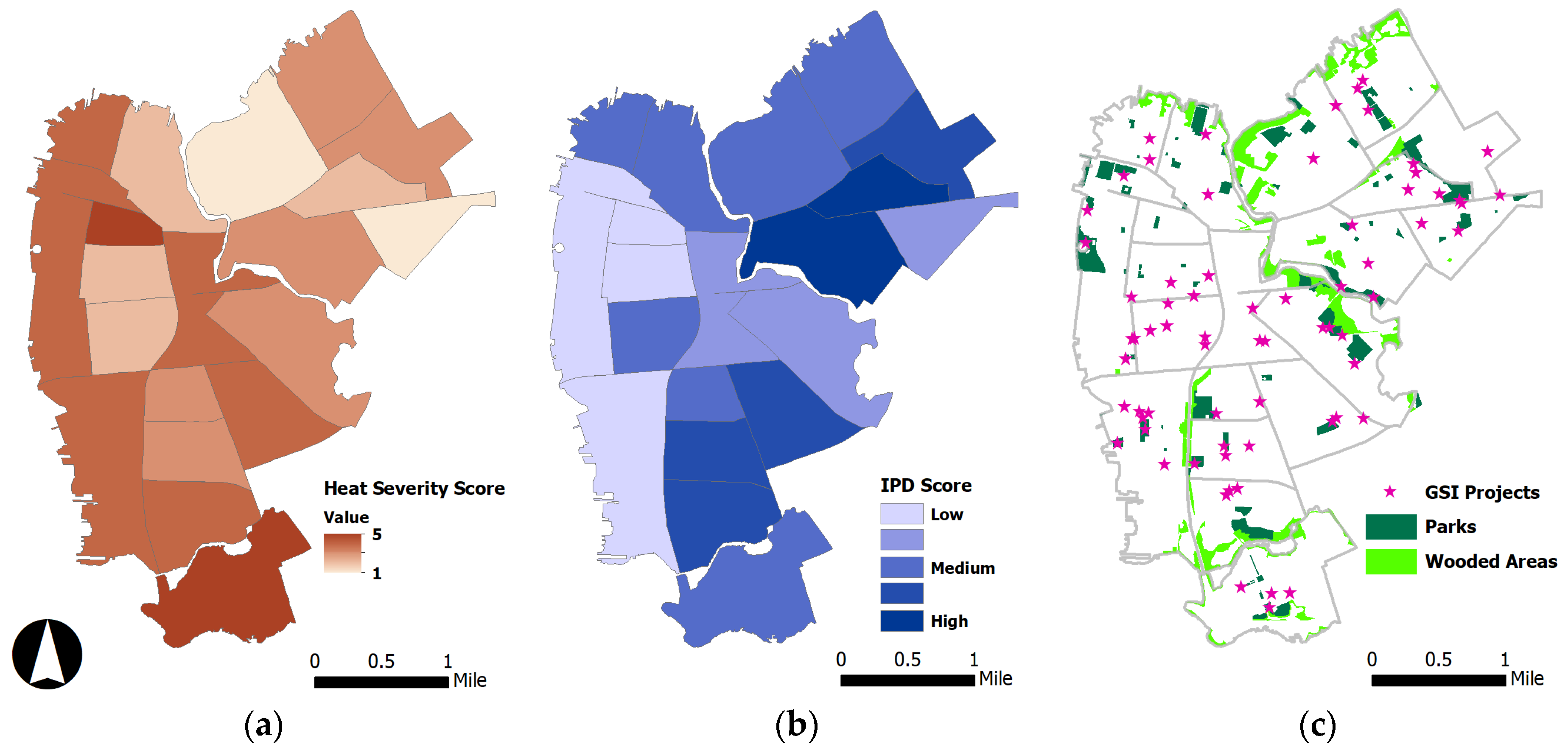
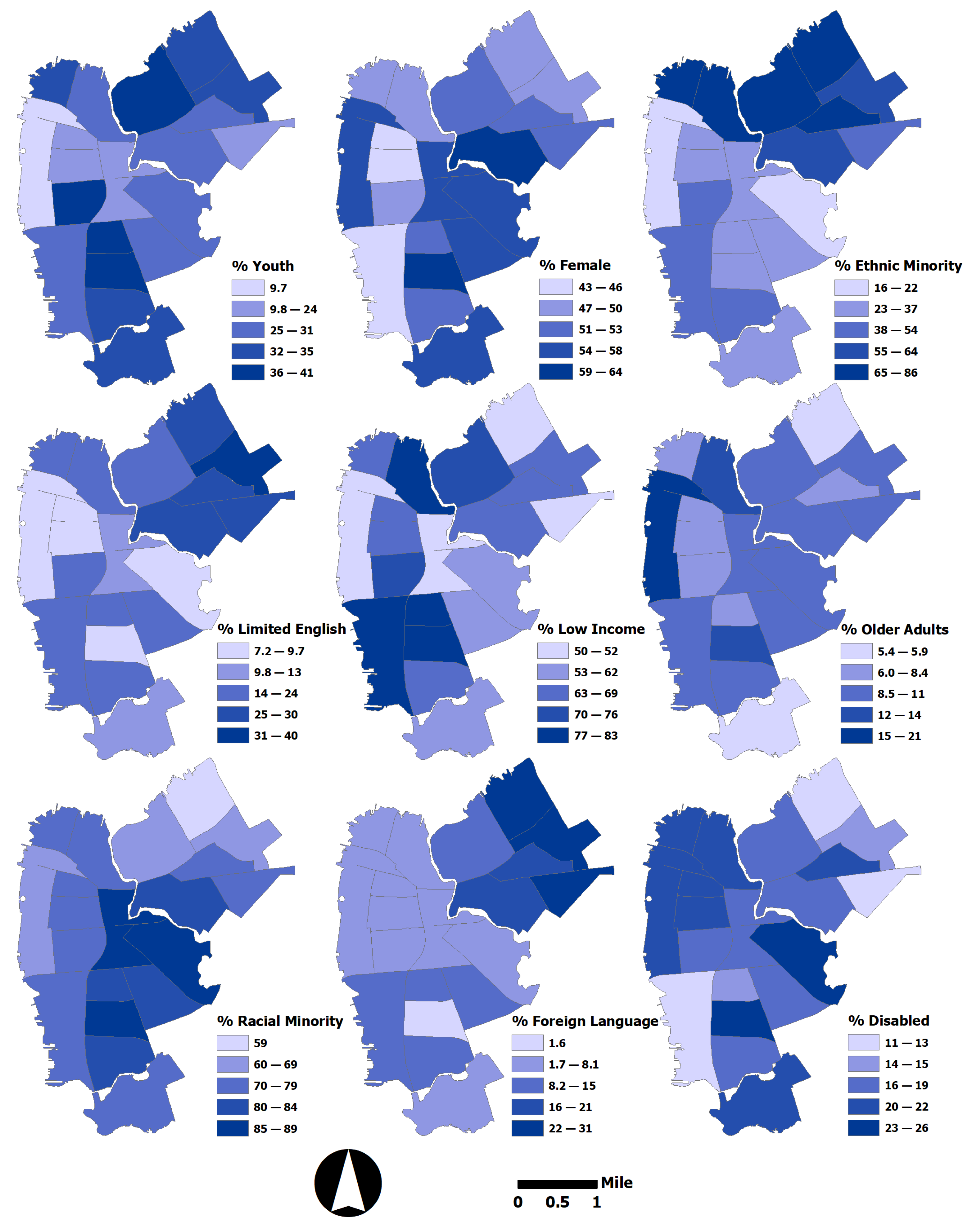
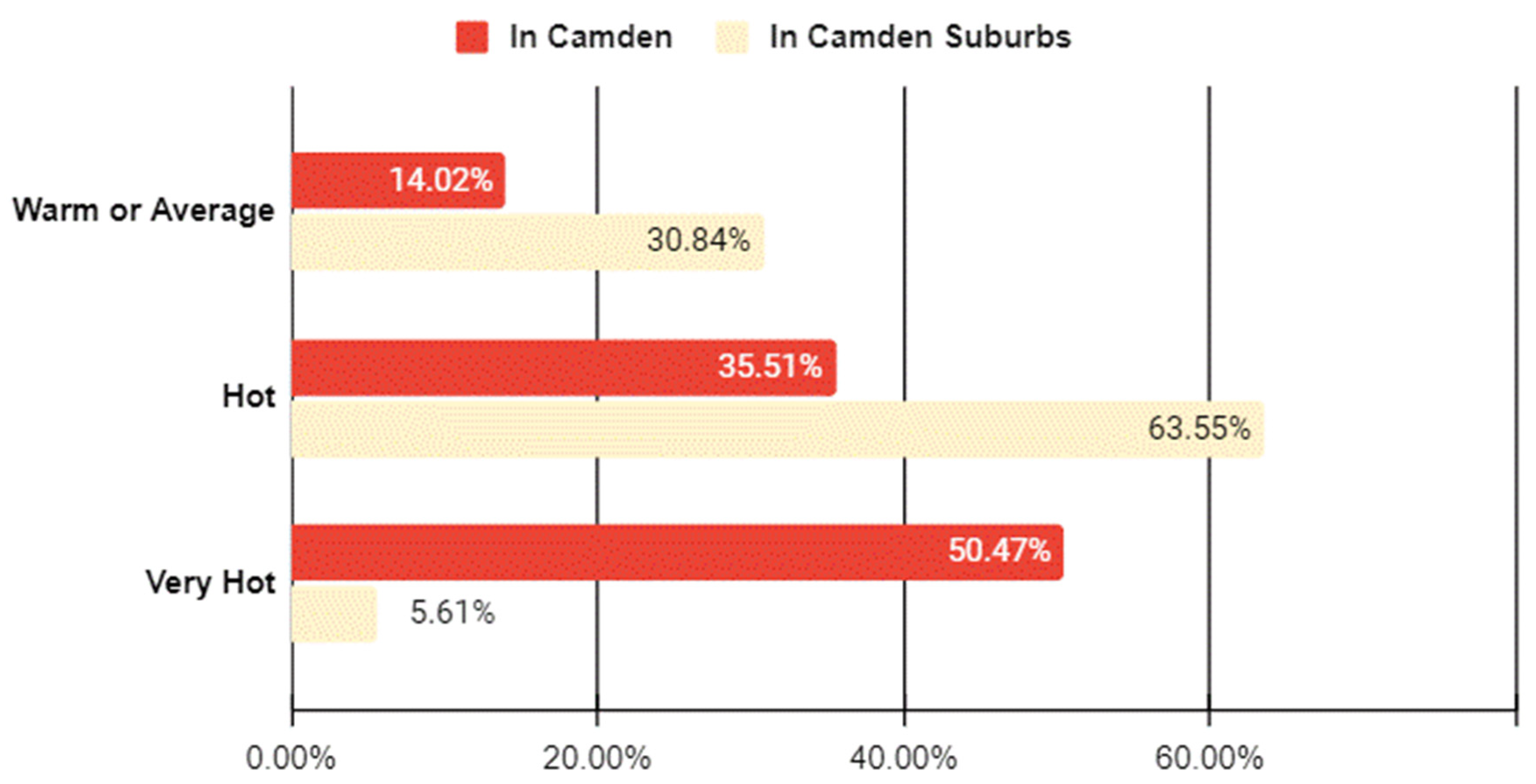
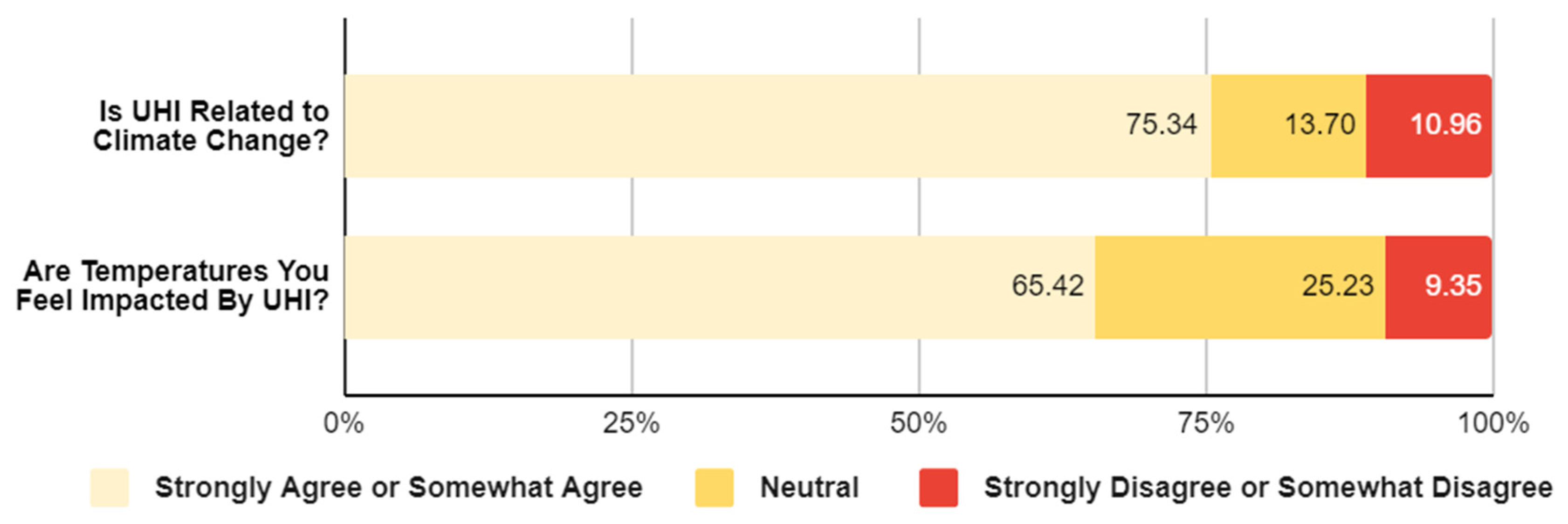


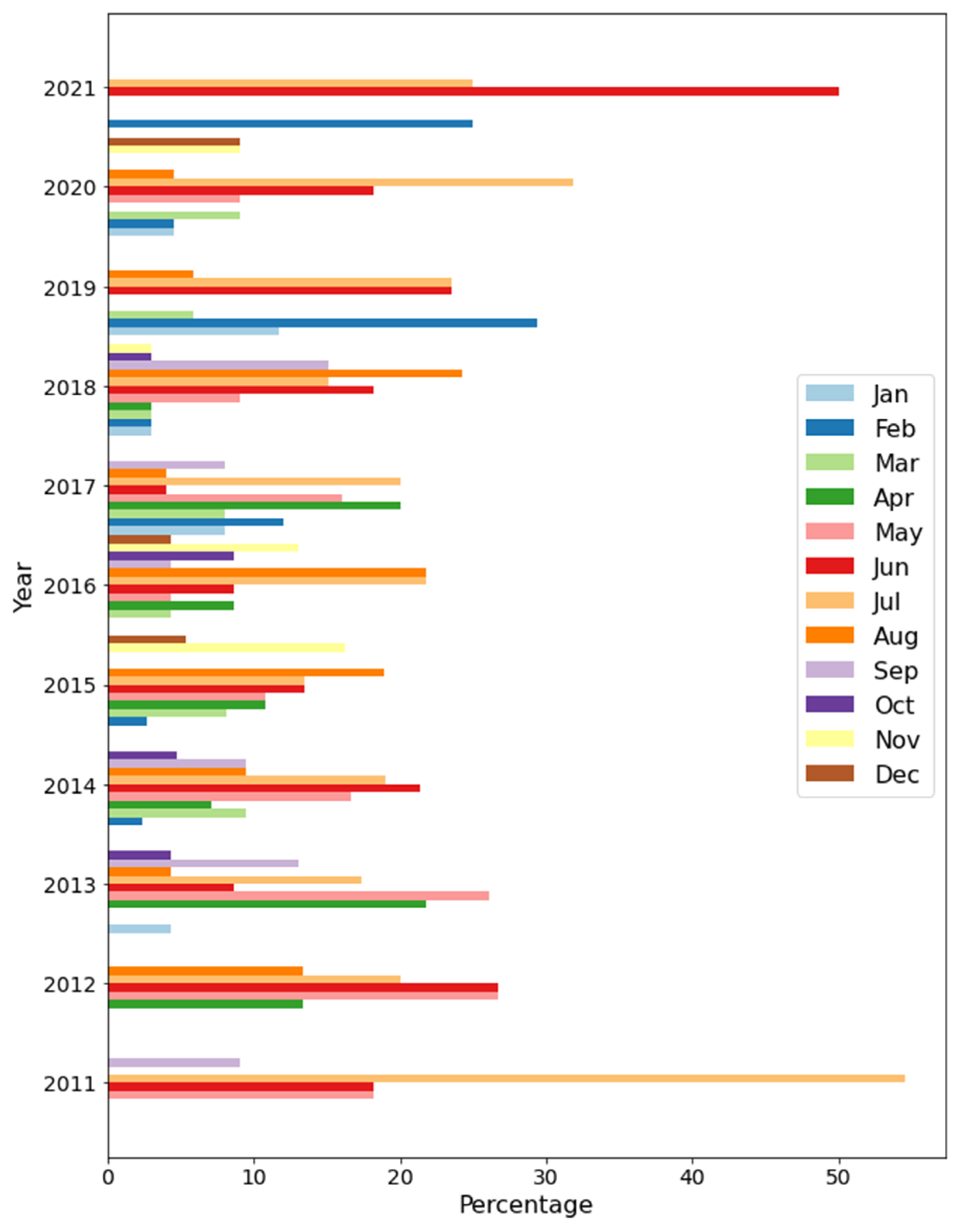
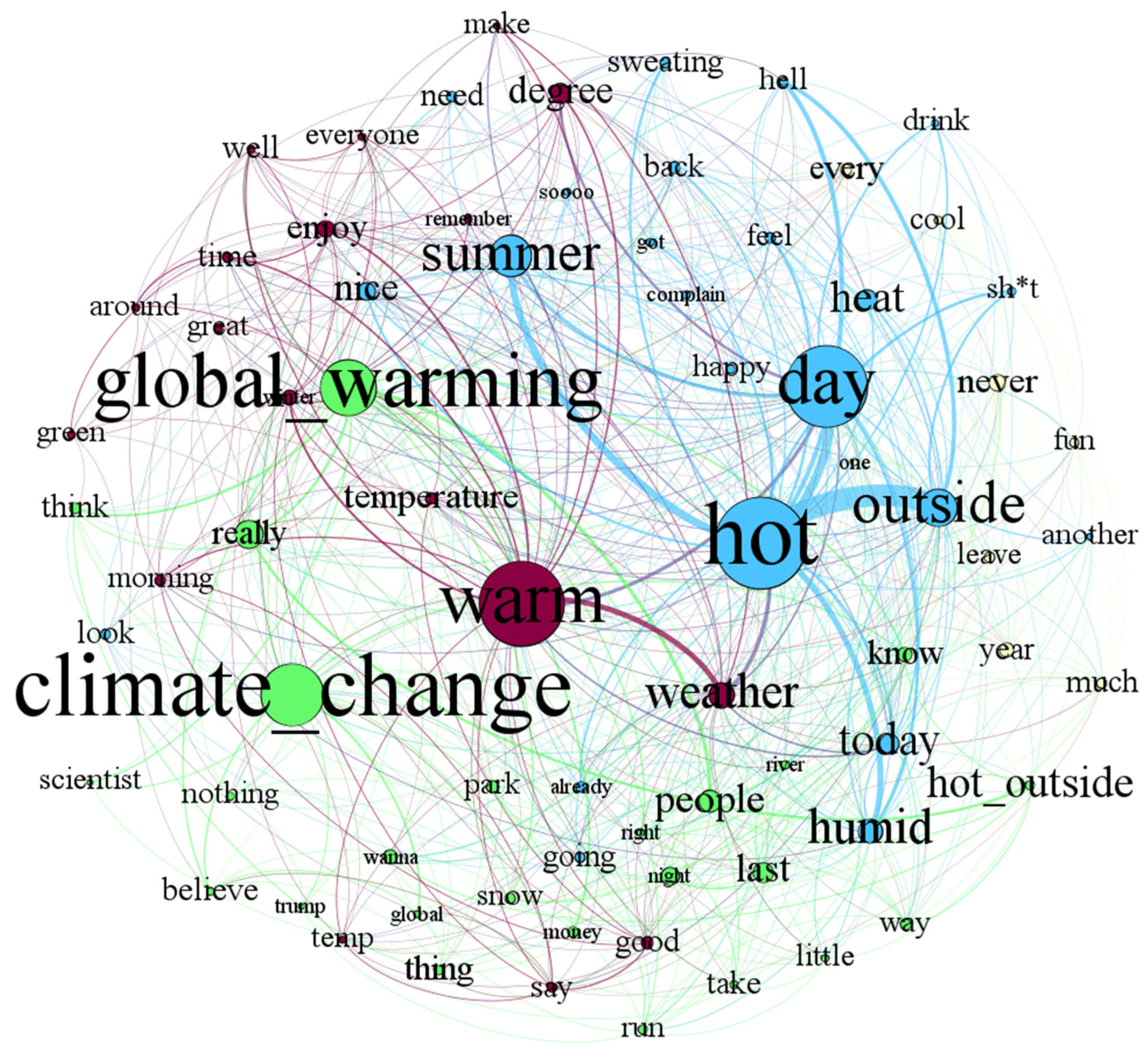
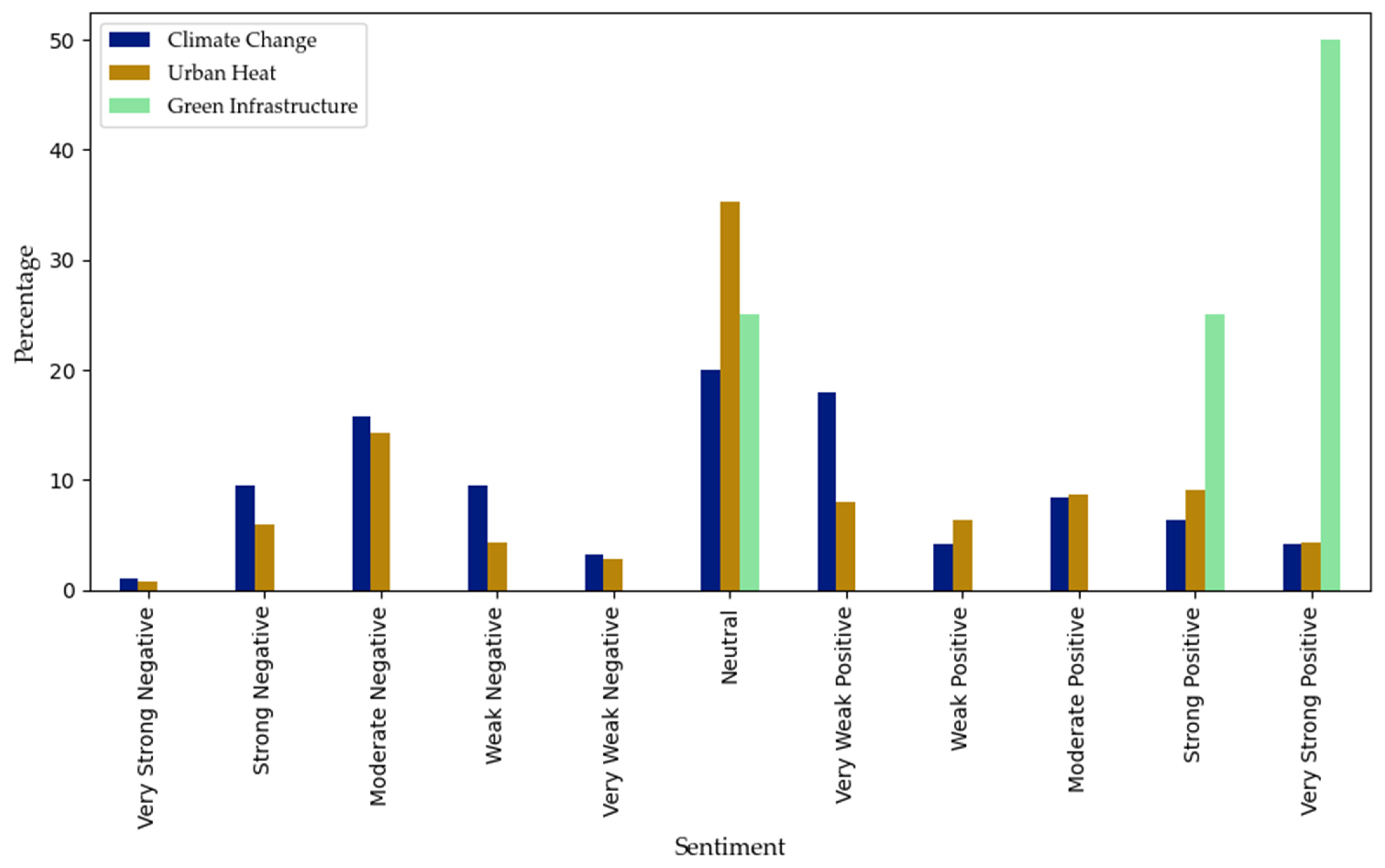
| Camden Neighborhood Name | Urban Heat Island (UHI) Score | Indicator of Potential Disadvantaged (IPD) Score | Impervious Surface (Acres) | Park Area (Acres) | Wooded Area (Acres) | Vacant Area (Acres) | Number of GSI Projects |
|---|---|---|---|---|---|---|---|
| Bergen Square | 2.882 | 26 | 1151.1 | 0.2 | 0 | 55.1 | 11 |
| Biedeman | 3.019 | 26 | 2103 | 14.5 | 52 | 39.9 | 4 |
| Centerville | 3.032 | 29 | 1188.1 | 8.8 | 6.4 | 15.5 | 4 |
| Central Business District | 4.494 | 21 | 1131.5 | 2 | 0 | 0.4 | 0 |
| Cooper Grant/Waterfront | 3.395 | 22 | 2492.2 | 59.4 | 0.9 | 21 | 10 |
| Cooper Point | 3.408 | 27 | 1142.2 | 1.7 | 20.4 | 51.3 | 3 |
| Cramer Hill | 2.346 | 27 | 1283.2 | 23.2 | 72.8 | 71.1 | 4 |
| Dudley | 2.861 | 30 | 1195.2 | 34.9 | 12.2 | 14.4 | 10 |
| Fairview | 3.986 | 27 | 1670.6 | 14.4 | 46.8 | 33.7 | 7 |
| Gateway | 3.373 | 24 | 2276.5 | 6.8 | 43.5 | 50.1 | 6 |
| Lanning Square | 2.774 | 21 | 1152.6 | 3.2 | 0 | 18.1 | 8 |
| Liberty Park | 3.043 | 27 | 1124.4 | 16 | 7.3 | 4.3 | 3 |
| Marlton | 3.034 | 31 | 2156.7 | 20.1 | 20.6 | 44.2 | 5 |
| Morgan Village | 3.69 | 28 | 1218.2 | 20.1 | 42.2 | 15.2 | 8 |
| Parkside | 2.955 | 24 | 1398.1 | 33.4 | 53 | 19.8 | 7 |
| Pyne Poynt | 2.816 | 27 | 1172.3 | 21.8 | 33.8 | 44 | 4 |
| Rosedale | 3.079 | 28 | 2090.1 | 32.5 | 10.2 | 12.8 | 3 |
| Stockton | 2.29 | 25 | 2049 | 10.4 | 0.5 | 1.8 | 4 |
| Waterfront South | 3.424 | 22 | 1347.5 | 11 | 18.3 | 77.1 | 14 |
| Whitman Park | 3.625 | 28 | 1439.9 | 8.7 | 0 | 16 | 6 |
| (1) | (2) | (3) | (4) | (5) | (6) | (7) | (8) | (9) | |
|---|---|---|---|---|---|---|---|---|---|
| Variables | Camden Too Hot | Camden has UHI Effect Dummy | Camden Suburbs Too Hot | UHI Triggers Negative Emotions Dummy | Climate Change Impacts UHI Dummy | GI Presence Dummy | GI Impacts UHI Dummy | Vegetation Presence Dummy | Vegetation Impacts UHI Dummy |
| Live in Camden dummy | 0.478 ** | 0.257 * | 0.317* | 0.035 | 0.287 * | 0.108 | 0.302 * | 0.199 | 0.081 |
| (0.232) | (0.154) | (0.184) | (0.135) | (0.158) | (0.153) | (0.164) | (0.160) | (0.101) | |
| Work in Camden dummy | 0.017 | 0.197 | 0.319* | 0.023 | −0.057 | 0.269 * | 0.286 * | 0.476 *** | 0.105 |
| (0.235) | (0.156) | (0.186) | (0.137) | (0.160) | (0.155) | (0.166) | (0.162) | (0.103) | |
| Live and work in Camden dummy | 0.501 ** | 0.482 *** | 0.209 | 0.078 | 0.207 | 0.284 * | 0.308* | 0.164 | 0.219 ** |
| (0.250) | (0.166) | (0.198) | (0.146) | (0.170) | (0.165) | (0.177) | (0.173) | (0.109) | |
| Neighborhood UHI score | 0.287 | 0.031 | 0.197 | 0.092 | 0.010 | 0.097 | −0.072 | −0.101 | −0.124 |
| (0.182) | (0.121) | (0.145) | (0.106) | (0.124) | (0.120) | (0.129) | (0.126) | (0.080) | |
| Neighborhood IPD score | −0.004 | −0.027 | 0.048 | −0.004 | 0.040 | 0.001 | −0.008 | 0.032 | 0.000 |
| (0.038) | (0.025) | (0.030) | (0.022) | (0.026) | (0.025) | (0.027) | (0.026) | (0.017) | |
| Log of impervious surface | −0.209 | −0.194 | −0.238 | −0.489 * | 0.004 | −0.293 | −0.120 | 0.340 | 0.051 |
| (0.437) | (0.291) | (0.347) | (0.255) | (0.297) | (0.288) | (0.310) | (0.302) | (0.191) | |
| Log of park area | −0.022 | −0.062 | 0.008 | 0.159 ** | −0.061 | 0.051 | −0.099 | −0.011 | −0.058 |
| (0.134) | (0.089) | (0.106) | (0.078) | (0.091) | (0.088) | (0.095) | (0.092) | (0.058) | |
| Log of wooded area | 0.037 | 0.021 | 0.008 | 0.000 | 0.014 | −0.040 | −0.005 | −0.003 | 0.083 * |
| (0.101) | (0.067) | (0.080) | (0.059) | (0.068) | (0.066) | (0.071) | (0.070) | (0.044) | |
| Log of vacant area | −0.130 | 0.037 | 0.007 | −0.053 | −0.078 | 0.035 | −0.103 | 0.013 | −0.142 * |
| (0.188) | (0.125) | (0.149) | (0.110) | (0.128) | (0.124) | (0.133) | (0.130) | (0.082) | |
| Log of number of GSI projects | 0.264 | −0.007 | 0.106 | 0.151 | 0.007 | 0.098 | 0.188 | −0.044 | 0.023 |
| (0.216) | (0.144) | (0.171) | (0.126) | (0.147) | (0.142) | (0.153) | (0.149) | (0.095) | |
| Log of household income | 0.134 | 0.162 | 0.081 | 0.119 | 0.097 | 0.408 | 0.413 | 0.287 | 0.103 |
| (0.374) | (0.249) | (0.297) | (0.218) | (0.254) | (0.246) | (0.265) | (0.259) | (0.164) | |
| Percent of pop. under poverty | 0.005 | 0.001 | 0.003 | 0.001 | −0.001 | −0.006 | −0.005 | −0.001 | 0.001 |
| (0.010) | (0.007) | (0.008) | (0.006) | (0.007) | (0.007) | (0.007) | (0.007) | (0.004) | |
| Constant | 1.043 | 0.693 | 0.173 | 2.359 | −1.256 | −1.879 | −2.090 | −5.452 | 0.096 |
| (5.551) | (3.694) | (4.402) | (3.238) | (3.776) | (3.657) | (3.938) | (3.839) | (2.430) | |
| Observations | 107 | 107 | 107 | 107 | 107 | 107 | 107 | 107 | 107 |
| R-squared | 0.165 | 0.163 | 0.106 | 0.138 | 0.208 | 0.115 | 0.117 | 0.180 | 0.177 |
| ID | Sample X Posts | Time |
|---|---|---|
| 1 | “It’s 60 degrees in January but climate change isn’t real?” | January 2018 |
| 2 | “Going to be a rough summer. Climate change is here to stay.” | June 2021 |
| 3 | “… [I] stopped of the plane and felt like I walked into a 90° hot house. It has not cooled. No breeze. I am sweating down my back. And I love it. It’s so nice. Instinctively I want to complain, but i can’t.” | June 2019 |
| 4 | “It’s a very comfortable 110 degree heat index today. Swampy. Just the way I like it.” | July 2011 |
| 5 | “It is warm, sunny, and breezy, and I get to spend my day with this [festival] lineup…” | July 2018 |
| 6 | “Made it out this evening to finish up the miles that I couldn’t complete in the heat yesterday. It was still pretty hot this evening, but not as humid. No running, just a two mile [walking].” | August 2018 |
| 7 | “damn, it’s going to be extremely hot. My heart can’t do this let’s hope I don’t have a heat stroke [because] my school is 1000 [times] hotter than outside” | May 2014 |
| 8 | “Heat index of 105 today working outside … gotta get rid of this farmers tan somehow” | July 2017 |
Disclaimer/Publisher’s Note: The statements, opinions and data contained in all publications are solely those of the individual author(s) and contributor(s) and not of MDPI and/or the editor(s). MDPI and/or the editor(s) disclaim responsibility for any injury to people or property resulting from any ideas, methods, instructions or products referred to in the content. |
© 2023 by the authors. Licensee MDPI, Basel, Switzerland. This article is an open access article distributed under the terms and conditions of the Creative Commons Attribution (CC BY) license (https://creativecommons.org/licenses/by/4.0/).
Share and Cite
Meenar, M.; Rahman, M.S.; Russack, J.; Bauer, S.; Kapri, K. “The Urban Poor and Vulnerable Are Hit Hardest by the Heat”: A Heat Equity Lens to Understand Community Perceptions of Climate Change, Urban Heat Islands, and Green Infrastructure. Land 2023, 12, 2174. https://doi.org/10.3390/land12122174
Meenar M, Rahman MS, Russack J, Bauer S, Kapri K. “The Urban Poor and Vulnerable Are Hit Hardest by the Heat”: A Heat Equity Lens to Understand Community Perceptions of Climate Change, Urban Heat Islands, and Green Infrastructure. Land. 2023; 12(12):2174. https://doi.org/10.3390/land12122174
Chicago/Turabian StyleMeenar, Mahbubur, Md Shahinoor Rahman, Jason Russack, Sarah Bauer, and Kul Kapri. 2023. "“The Urban Poor and Vulnerable Are Hit Hardest by the Heat”: A Heat Equity Lens to Understand Community Perceptions of Climate Change, Urban Heat Islands, and Green Infrastructure" Land 12, no. 12: 2174. https://doi.org/10.3390/land12122174
APA StyleMeenar, M., Rahman, M. S., Russack, J., Bauer, S., & Kapri, K. (2023). “The Urban Poor and Vulnerable Are Hit Hardest by the Heat”: A Heat Equity Lens to Understand Community Perceptions of Climate Change, Urban Heat Islands, and Green Infrastructure. Land, 12(12), 2174. https://doi.org/10.3390/land12122174








